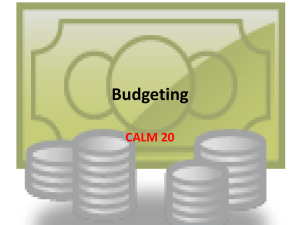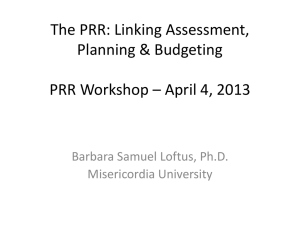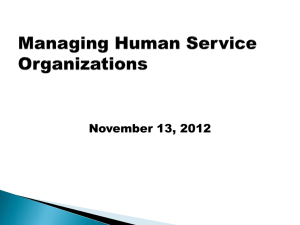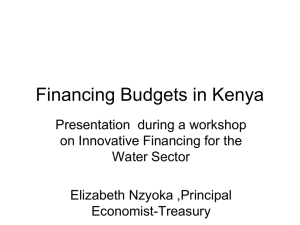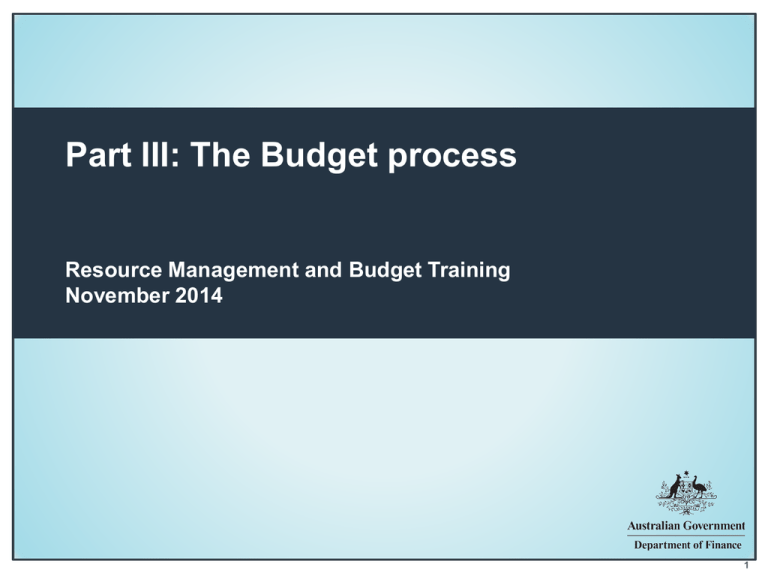
Part III: The Budget process
Resource Management and Budget Training
November 2014
1
Contact and acknowledgement information
©Commonwealth of Australia 2014
All material produced by the Department of Finance (Finance) constitutes copyright administered by Finance.
Finance reserves the right to set out the terms and conditions for the use of such material. Apart from any use
permitted under the Copyright Act 1968, and those explicitly granted herein, all other rights are reserved.
Unless otherwise noted, all material in this publication, except the Commonwealth Coat of Arms, and any
material protected by a trademark is licensed under the Creative Commons BY SA Attribution Share Alike 4.0
Australia Licence. Details of this licence are available at: http://creativecommons.org/licenses/by-sa/4.0/.
Enquiries
For enquiries or suggestions about this presentation, please contact training.team@finance.gov.au
Resource Management and Budget Training — Part III
2
Commonwealth Resource Management
Framework
Constitution
PGPA Act
Appropriation
acts
Other
legislation
Policy
Legislative instruments
Entity internal controls
reporting and
evaluation
proper use appropriations
earned autonomy
accountability
planning objectives
and strategies
governance property management transparency
audit
efficiency PUBLIC RESOURCES spending
procurement performance grants management
implementing
and monitoring
risk management cooperation with others
commitments
budgeting and
operational planning
3
The Budget Framework
Part I: The Resource
Management Framework
Part II: Use of public
resources
Part III: The Budget
process
• Commonwealth Resource
Management Framework
• Accountability and
performance
• The Budget Framework
• The Australian system of
government
• Risk management
• Implementing and
monitoring
• Appropriations
• Managing relevant property
• The PGPA Act
• Compliance reporting
• Spending relevant money
• Planning and budgeting
• Reporting and
evaluation
• Rules, policy and guidance
• Other legislation
Resource Management and Budget Training — Part III
4
The Budget Framework
Planning and budgeting
General
taxation
Non-tax
revenue
Consolidated
Revenue Fund
5
The Budget Framework
Planning and budgeting
700
600
400
300
200
Payments
100
Receipts
2024-25
2022-23
2020-21
2018-19
2016-17
2014-15
2012-13
2010-11
2008-09
2006-07
2004-05
0
2002-03
$ billion
500
Actuals
Estimates
backward looking
(records and explanations)
forward looking
(forecasts or projections)
6
The Budget Framework
Budget roles and responsibilities
Prime Minister and Cabinet
• agrees to the Budget process
• approves new revenue and expenditure decisions
Expenditure Review Committee (ERC)
• reviews portfolio ministers’ bids for funding (NPPs)
• includes expenditure, revenue and savings proposals
• recommends to Budget Cabinet which proposals should be:
• fully developed for consideration in the Budget
• included as final measures in the Budget
Parliamentary Budget Office (PBO)
• prepares costings and analysis on financial or economic
matters, as requested by Members of Parliament
Resource Management and Budget Training — Part III
7
The Budget Framework
Budget roles and responsibilities
Central departments (PM&C, Treasury, Finance)
• manages Budget process in accordance with legislation, policy
and convention (Finance and Treasury)
• costs all expense, capital and savings proposals (Finance)
• costs all revenue proposals (Treasury)
• manages Cabinet meetings and approvals for NPPs (PM&C)
Commonwealth entities
• develop NPPs for consideration by Ministers, as part of Portfolio
Budget Submissions
• update their estimates and actuals for public reporting
Resource Management and Budget Training — Part III
8
The Budget Framework
Relevant legislation and policy
PGPA Act
• requires accountable authorities to prepare
budget estimates
Section
36
Charter of Budget Honesty Act
• sets planning and reporting requirements
• aims to improve policy outcomes and public scrutiny
Budget Process Operational Rules (BPORs)
• sets out rules and timing for each year’s Budget process
Cabinet Handbook
• sets out the process for preparing submissions
Resource Management and Budget Training — Part III
9
The Budget Framework
Charter reporting requirements
• Fiscal strategy statements (Budget Paper No 1)
• Regular fiscal reporting
• Budget economic and fiscal outlook report
• Mid-Year Economic and Fiscal Outlook (MYEFO) report
• Final Budget Outcome (FBO) report
• Intergenerational reports
• Pre-election economic and fiscal outlook reports
• costings for election policies
Resource Management and Budget Training — Part III
10
The Budget Framework
Contents of the Budget
Budget papers
•
•
•
•
No. 1 Budget Strategy and Outlook
No. 2 Budget Measures
No. 3 Federal Financial Relations
No. 4 Agency Resourcing
Appropriation bills
Budget related
•
•
•
•
•
Portfolio Budget Statements
Budget Speech
Budget Overview
Budget at a Glance
Ministerial Statements
(Intergenerational Report)
• Appropriation Bill (No.1)
• Appropriation Bill (No.2)
• Appropriation (Parliamentary Departments) Bill (No.1)
11
The Budget Framework
Budget tools
Central Budget Management System (CBMS)
• Budget Estimates and Actuals Management (BEAM)
• Entities add agreed estimates for the NPPs
• Finance reviews and validates the estimates
• Budget Policy and Coordination Database (BPCD)
• details about the measures
• links relevant estimates in BEAM
INPACT new policy and costings tracker
• allows Finance to track policies and costings
• captures submissions, NPPs, costing agreements and
Government decisions
Resource Management and Budget Training — Part III
12
The Budget Framework
Three year budget cycle
Year 3: Post-budget year
• reporting
• audit
Year 1: Pre-budget year
Reporting
and
evaluation
Planning
objectives
and
strategies
Implementing
and
monitoring
Budgeting
and
operational
planning
Year 2: Budget year
• monitoring and
adjusting
• fiscal strategy set
• allocation of public
resources
• parliament and the
public informed about
these decisions
• appropriations put to
Parliament for
approval
Resource Management and Budget Training — Part III
13
The Budget Framework
Three year budget cycle
Jul
Aug
Sep
Oct
Nov
Dec
Jan
Feb
Mar
Apr
May
Jun
Pre-Budget Year
Government
sets BPORs and
timing
Government
undertakes
initial strategic
budget planning
Portfolio
minister
proposes policy
priorities to the
PM
ERC considers policy priorities
Portfolio
departments
prepare draft
PBSs
Finance agrees
costings
contained in
draft PBSs
PM decides
which proposals
may be
submitted to
ERC
Portfolio
departments
lodge final PBSs
to Cabinet
Secretariat
ERC considers NPPs contained in
the PBSs
CBMS: pre-ERC
estimates
update
Risk and
assurance
processes
CBMS: Budget
estimates
update
Budget Cabinet
considers NPPs
approved by
ERC
Budget papers
produced
Budget night
(2nd Tuesday)
Budget papers
and
appropriation
bills introduced
to Parliament
Senate
Legislation
Committee
hearings
Appropriation
bills considered
and usually
passed by
Parliament by
end of June
Budget Year
Performance monitoring
MYEFO papers produced
Senate estimates hearings
Additional estimates bills passed by Parliament
(usually by end of April)
Additional Estimates appropriation bills prepared
Supplementary additional
estimates appropriation bills
prepared and introduced to
Parliament, if required
Post-Budget Year
Entities prepare annual reports
(audited by ANAO)
Final Budget
Outcomes (FBO)
published by
Finance
Entities’ annual
reports
published
Consolidated
Financial
Statements
(CFSs) audited
by ANAO and
published by
Finance
Finance Minister provides report
to Parliament on the use of
Advances to the Finance Minister
(AFMs)
Parliament
passes AFM
report (usually
by end of April)
14
Planning and budgeting
Part I: The Resource
Management Framework
Part II: Use of public
resources
Part III: The Budget
process
• Commonwealth Resource
Planning
Management Framework
• Accountability and
performance
• The Budget Framework
•
• Risk management
• Implementing and
monitoring
objectives and
The Australian system
of
strategies
government
• Appropriations
•
Budgeting and
The PGPA Act operational
planning
• Spending relevant money
• Managing relevant property
• Compliance reporting
• Planning and budgeting
• Reporting and
evaluation
• Rules, policy and guidance
• Other legislation
Resource Management and Budget Training — Part III
15
Planning and budgeting
Budget Process Operational Rules
Process
Purpose
Indicative timing
Government sets operational timing
Budget Process Operational Rules considered by Cabinet. Process and
timetable are formally set
September
Ministers submit draft proposals
Ministers outline draft proposals for the coming budget
October
Estimates updated at Mid-Year
Economic and Fiscal Outlook
Estimates of spending and revenue are updated and policy decisions
since the last Budget are reported
October/November
Budget priorities are set
Ministers’ draft proposals are reviewed by Expenditure Review
Committee and budget priorities are established.
Late November
Portfolio budget
submissions
Departments prepare submissions. Finance and Treasury agree on
costings for all new policy proposals. All central departments provide
feedback to portfolio departments on the quality and content of
submissions coming forward in the context of the Budget.
January
Central departments review/
pre-ERC estimates update
Central departments review submissions and Finance prepares briefs for
ERC and pre-ERC estimates update
January/February
Expenditure Review Committee
ERC reviews proposals and recommends which proposals should be
included in the Budget (Finance Green Briefs inform this process)
March
Pre-budget review
Entities update estimates to reflect ERC’s recommendations prior to
finalising the Budget
April
Budget Cabinet
Special sitting of Cabinet is held to consider and confirm ERC decisions
and agree on final Budget measures
Late April
Budget night
Government’s decisions about budget management are announced.
Appropriation Bills tabled for consideration by parliament.
May
16
Planning and budgeting
Planning
objectives
and
strategies
Pre-budget year
Jul
Aug
Jan
Feb
Portfolio departments
prepare draft PBSs
Portfolio
departments lodge
final PBSs to Cabinet
Secretariat
Finance agrees
costings contained in
draft PBSs
Risk and assurance
processes
Budgeting
and
operational
planning
Sep
Oct
Government sets
BPORs and timing
Portfolio minister
propose policy
priorities to the Prime
Minister
Government
undertakes initial
strategic budget
planning
Prime Minister
decides which
proposals may be
submitted to ERC
Mar
Apr
May
CBMS: Budget
estimates update
Budget papers
produced
ERC considers NPPs contained in the PBSs
CBMS: pre-ERC
estimates update
Budget Cabinet
considers NPPs
approved by ERC
Nov
Dec
ERC considers policy priorities
Budget night
(2nd Tuesday)
Budget papers and
appropriation bills
introduced to
Parliament
Jun
Budget night
(2nd Tuesday)
Budget papers and
appropriation bills
introduced to
Parliament
Appropriation bills
considered and
usually passed by
Parliament by end of
June
17
Planning and budgeting
Planning
objectives
and
strategies
Costing process — key elements
Budgeting
and
operational
planning
Prepare
Understand Finance’s
role in policy costing
Understand Finance’s
costing protocols
Develop clear policy description,
RPAT and complete costing
Understand and clarify policy
Ascertain if policy is
being funded correctly
Clarify key policy
implementation issues
Interpret policy
Cost departmental expenses
Assess general costing
assumptions and
information
Assess staffing costs and
standard on-costs or
overheads
Assess nonstandard
operating costs
Assess operating costs
associated with capital
funding protocols
Apply efficiency
dividend
Apply indexation to
forward year costs as
required
Cost administered expenses
Apply indexation to forward
year costs as required
Assess general information
and costing data
Assess implementation and
evaluation assumptions
Assess assumptions behind
the key cost drivers
Cost capital and ICT funding proposals
Does proposal require?
1. Full business case
2. Gateway clearance
3. Two-stage clearance
Assess proposal
(business case) with
lifecycle costing
approach
Costing
sign-off
As required, seek expert
input/assistance to
assess proposal (e.g.
FMG, AMPS, AGIMO)
Clearly identify
operating expenses
associated with the
proposed capital asset
Apply indexation to
forward year costs as
required
Calculate impact on
resourcing and Budget
balances
18
Planning and budgeting
Where does an NPP come from?
Planning
objectives
and
strategies
Budgeting
and
operational
planning
A few things to remember:
• Policy landscape is not a blank canvass
• New policy can involve a change to an existing program or
activity.
Policies come from:
• Government direction, such as election commitments
• Entities, through improving core business or new ideas
• Other sources, such as reports produced within or outside
Government
Resource Management and Budget Training — Part III
19
Planning and budgeting
Planning
objectives
and
strategies
Discussion
Budgeting
and
operational
planning
NPP to build and support schools
in regional and remote areas
(Page 2 of the Activity Book)
Resource Management and Budget Training — Part III
20
Planning and budgeting
Developing an NPP
Planning
objectives
and
strategies
Budgeting
and
operational
planning
Information government needs to make a decision about
an NPP…
•
•
•
•
•
•
•
•
•
•
•
what is being proposed and why?
does the proposal have authority to come forward?
which entities will be affected?
is there agreement between entities?
how will the proposal be implemented?
how much will it cost?
is legislation required?
what are the risks and how will they be managed?
are there any broader impacts?
have the right people been consulted?
how will performance be measured?
Resource Management and Budget Training — Part III
21
Planning and budgeting
Planning
objectives
and
strategies
Costing process — key elements
Budgeting
and
operational
planning
Prepare
Understand Finance’s
role in policy costing
Understand Finance’s
costing protocols
Develop clear policy description,
RPAT and complete costing
Understand and clarify policy
Ascertain if policy is
being funded correctly
Clarify key policy
implementation issues
Interpret policy
Cost departmental expenses
Assess general costing
assumptions and
information
Assess staffing costs and
standard on-costs or
overheads
Assess nonstandard
operating costs
Assess operating costs
associated with capital
funding protocols
Apply efficiency
dividend
Apply indexation to
forward year costs as
required
Cost administered expenses
Apply indexation to forward
year costs as required
Assess general information
and costing data
Assess implementation and
evaluation assumptions
Assess assumptions behind
the key cost drivers
Cost capital and ICT funding proposals
Does proposal require?
1. Full business case
2. Gateway clearance
3. Two-stage clearance
Assess proposal
(business case) with
lifecycle costing
approach
Costing
sign-off
As required, seek expert
input/assistance to
assess proposal (e.g.
FMG, AMPS, AGIMO)
Clearly identify
operating expenses
associated with the
proposed capital asset
Apply indexation to
forward year costs as
required
Calculate impact on
resourcing and Budget
balances
22
Planning and budgeting
Planning
objectives
and
strategies
Entities & Finance: High-level
elements of a costing
• understanding the policy
• costing departmental items
• costing administered items
(on behalf of Commonwealth)
• costing capital and ICT funding
(Gateway, 2 Pass review)
Budgeting
and
operational
planning
Considerations:
•
•
•
•
•
Number of staff required
Level of staff required
Assumptions
Cost components
Cost drivers
(price/volume)
• Options
• Business cases, etc
Resource Management and Budget Training — Part III
23
Planning and budgeting
Planning
objectives
and
strategies
Costing process — key elements
Budgeting
and
operational
planning
Prepare
Understand Finance’s
role in policy costing
Understand Finance’s
costing protocols
Develop clear policy description,
RPAT and complete costing
Understand and clarify policy
Ascertain if policy is
being funded correctly
Clarify key policy
implementation issues
Interpret policy
Cost departmental expenses
Assess general costing
assumptions and
information
Assess staffing costs and
standard on-costs or
overheads
Assess nonstandard
operating costs
Assess operating costs
associated with capital
funding protocols
Apply efficiency
dividend
Apply indexation to
forward year costs as
required
Cost administered expenses
Apply indexation to forward
year costs as required
Assess general information
and costing data
Assess implementation and
evaluation assumptions
Assess assumptions behind
the key cost drivers
Cost capital and ICT funding proposals
Does proposal require?
1. Full business case
2. Gateway clearance
3. Two-stage clearance
Assess proposal
(business case) with
lifecycle costing
approach
Costing
sign-off
As required, seek expert
input/assistance to
assess proposal (e.g.
FMG, AMPS, AGIMO)
Clearly identify
operating expenses
associated with the
proposed capital asset
Apply indexation to
forward year costs as
required
Calculate impact on
resourcing and Budget
balances
24
Planning and budgeting
Entity and Finance: Risk assessment
Planning
objectives
and
strategies
Budgeting
and
operational
planning
to assess the broader impacts that an NPP could have,
entities must consider:
• nature and intent of the proposal
• components that are by nature higher risk (e.g., ICT, remote
distance), which require more detailed assurance processes
• possible impacts on the different sectors, either directly or
indirectly:
• regulatory impacts (consistent with Government’s red tape reduction
agenda)
• families, indigenous, regional areas and small businesses
Resource Management and Budget Training — Part III
25
Planning and budgeting
Activity: Preparing a costing for an NPP
Planning
objectives
and
strategies
Budgeting
and
operational
planning
(Pages 2-8 of the Activity Book)
26
Planning and budgeting
Planning
objectives
and
strategies
Pre-budget year
Jul
Aug
Jan
Feb
Portfolio departments
prepare draft PBSs
Portfolio
departments lodge
final PBSs to Cabinet
Secretariat
Finance agrees
costings contained in
draft PBSs
Risk and assurance
processes
Budgeting
and
operational
planning
Sep
Oct
Government sets
BPORs and timing
Portfolio minister
propose policy
priorities to the Prime
Minister
Government
undertakes initial
strategic budget
planning
Prime Minister
decides which
proposals may be
submitted to ERC
Mar
Apr
May
Jun
CBMS: Budget
estimates update
Budget papers
produced
Senate Legislation
Committee hearings
Budget night
(2nd Tuesday)
Budget papers and
appropriation bills
introduced to
Parliament
Appropriation bills
considered and
usually passed by
Parliament by end of
June
ERC considers NPPs contained in the PBSs
CBMS: pre-ERC
estimates update
Budget Cabinet
considers NPPs
approved by ERC
Nov
Dec
ERC considers policy priorities
27
Planning and budgeting
Preparing Portfolio Budget Submissions
Planning
objectives
and
strategies
Budgeting
and
operational
planning
• prepared on a portfolio basis
• presented to Cabinet by the relevant Minister
• Cabinet Handbook process
• costings agreed between entity and Finance from relevant
entities and central departments
• exposure drafts of the submission distributed
• coordination comments obtained from relevant entities and
central departments
• final submissions then provided to ERC
Resource Management and Budget Training — Part III
28
Planning and budgeting
Expenditure Review Principles
Appropriateness
Effectiveness
Strategic policy
alignment
Efficiency
Performance
assessment
Integration
Planning
objectives
and
strategies
Budgeting
and
operational
planning
Evidence
29
Planning and budgeting
Discussion:
Expenditure Review Principles
Planning
objectives
and
strategies
Budgeting
and
operational
planning
(Pages 2-8 of the Activity Book)
Examine the costing you prepared in light of the
Expenditure Review Principles
• How would you weigh the different principles in this
particular scenario?
• Would you weigh them differently for other types of costings?
Resource Management and Budget Training — Part III
30
Planning and budgeting
Planning
objectives
and
strategies
Budget Cabinet
Expenditure Review
Committee decisions
Budgeting
and
operational
planning
Budget Cabinet
Cabinet decisions
Resource Management and Budget Training — Part III
31
Planning and budgeting
Budget Night: Budget delivered to
Parliament
Planning
objectives
and
strategies
Budgeting
and
operational
planning
32
Planning and budgeting
Contents of the Budget
Budget papers
•
•
•
•
No. 1 Budget Strategy and Outlook
No. 2 Budget Measures
No. 3 Federal Financial Relations
No. 4 Agency Resourcing
Appropriation bills
• Appropriation Bill (No.1)
• Appropriation Bill (No.2)
• Appropriation (Parliamentary
Departments) Bill (No.1)
Budget related
•
•
•
•
•
Portfolio Budget Statements
Budget Speech
Budget Overview
Budget at a Glance
Ministerial Statements
(Intergenerational Report)
Resource Management and Budget Training — Part III
33
Planning and budgeting
Planning
objectives
and
strategies
Parliamentary consideration of
Appropriation Bills
Jul
Aug
Jan
Feb
Portfolio departments
prepare draft PBSs
Portfolio
departments lodge
final PBSs to Cabinet
Secretariat
Finance agrees
costings contained in
draft PBSs
Risk and assurance
processes
Sep
Oct
Government sets
BPORs and timing
Portfolio minister
propose policy
priorities to the Prime
Minister
Government
undertakes initial
strategic budget
planning
Prime Minister
decides which
proposals may be
submitted to ERC
Mar
Apr
May
Jun
CBMS: Budget
estimates update
Budget papers
produced
Senate Legislation
Committee hearings
Budget night
(2nd Tuesday)
Budget papers and
appropriation bills
introduced to
Parliament
Appropriation bills
considered and
usually passed by
Parliament by end of
June
ERC considers NPPs contained in the PBSs
CBMS: pre-ERC
estimates update
Budgeting
and
operational
planning
Budget Cabinet
considers NPPs
approved by ERC
Nov
Dec
ERC considers policy priorities
34
Planning and budgeting
Activity: Budget Family Feud
Resource Management and Budget Training — Part III
35
Implementing and monitoring
Part I: The Resource
Management Framework
Part II: Use of public
resources
Part III: The Budget
process
• Accountability and
• Commonwealth Resource
Implementing
performance
Management Framework
and monitoring
• Risk management
• The Australian system of
government
• Spending relevant money
• The Budget Framework
• Appropriations
• Managing relevant property
• The PGPA Act
• Compliance reporting
• Reporting and
evaluation
• Planning and budgeting
• Implementing and
monitoring
• Rules, policy and guidance
• Other legislation
Resource Management and Budget Training — Part III
36
Implementing and monitoring
Implementing
& monitoring
Budget year
Jul
Aug
Sep
Oct
Nov
Dec
Performance monitoring
MYEFO papers produced
1 July
budget year begins
Jan
Additional Estimates appropriation bills prepared
Feb
Mar
Apr
May
Additional
estimates bills
usually introduced
to Parliament
Jun
Performance monitoring
Senate estimates hearings
Additional estimates bills passed by Parliament
(usually by end of April)
Supplementary additional estimates
appropriation bills prepared and introduced
to Parliament, if required
• programmes may require adjustment
Resource Management and Budget Training — Part III
37
Implementing and monitoring
Reasons for adjustments
•
•
•
•
•
Implementing
& monitoring
new or revised Government decision(s)
programme specific parameter changes
movement of funds
interest equivalency payments
changes in environment
Resource Management and Budget Training — Part III
38
Implementing and monitoring
Estimates preparation
Implementing
& monitoring
Entities:
• prepare estimates and supporting documentation
• enter into CMBS and amend as necessary
Finance :
• validates entity estimates
• checks for authority, appropriate explanation, accuracy and
impact on baseline and financial statements
• prepares consolidated reports
Resource Management and Budget Training — Part III
39
Implementing and monitoring
Implementing
& monitoring
Additional annual appropriation Bills
Introduced in
May
Generally introduced
February to April
Introduced in
May
Budget
Additional
estimates
Supplementary
additional
estimates
Jul
Aug
Sep
Oct
Nov
Dec
Jan
Feb
Mar
Apr
May
Jun
Bills 5 & 6
Bills 3 & 4
Bills 1 & 2
40
Implementing and monitoring
Activity: Estimates and reports
Implementing
& monitoring
Performance indicators, estimates
and reports (Pages 12-15)
Resource Management and Budget Training — Part III
41
Reporting and evaluation
Part I: The Resource
Management Framework
• Commonwealth Resource
Management Framework
Part II: Use of public
resources
• Accountability and
performance
Reporting and
• Risk management
• The Australian system of evaluation
government
• Spending relevant money
• Appropriations
• Managing relevant property
• The PGPA Act
• Compliance reporting
Part III: The Budget
process
• The Budget Framework
• Planning and budgeting
• Implementing and
monitoring
• Reporting and
evaluation
• Rules, policy and guidance
• Other legislation
Resource Management and Budget Training — Part III
42
Reporting and evaluation
Relevant legislation
Reporting
and
evaluation
PGPA Act
• requires financial and performance reports from entities
• focus on better information for Parliament and the public
• clear line of sight from corporate plans and PBS
to annual reports
Charter of Budget Honesty Act
• specifies arrangements for budget reporting
Auditor-General Act
• specifies the auditing role and responsibilities of the
Auditor-General and the ANAO
Resource Management and Budget Training — Part III
43
Reporting and evaluation
Reporting requirements
Jul
Aug
Sep
Aug
Nov
Dec
Jan
Feb
Mar
Apr
Budget reporting
Pre-budget year:
Jul
Oct
Reporting
and
evaluation
Oct
Nov
Dec
Jan
Feb
Mar
Jun
Budget
night
• annual forecast
• support Budget-related decisions of Government
• provides the fiscal outlook for the economy
Sep
May
Apr
May
Jun
Monthly financial statements
Budget year:
MYEFO / Additional Estimates
Budget-year reporting
• provides updated estimates
• allows assessment of performance against fiscal strategy
• takes into account government decisions
Jul
Aug
Post-budget year:
Sep
Oct
Final
Budget
Outcome
Entity
annual
reports
Nov
Consolidated
Financial
Statements
Dec
Jan
Feb
Mar
Apr
May
Jun
Post-budget outcomes
• compares actual results to previous estimates
• covers Commonwealth public sector,
general government sector and individual entities
44
Reporting and evaluation
Post budget year reporting
Jul
Aug
Sep
Entities prepare annual reports (audited by ANAO)
Oct
Entities’ annual
reports published
Final Budget
Outcomes (FBO)
published by
Finance
Jan
Feb
Finance Minister provides report to
Parliament on the use of Advances to the
Finance Minister (AFMs)
Mar
Apr
Reporting
and
evaluation
Nov
Dec
Consolidated
Financial
Statements (CFSs)
audited by ANAO
and published by
Finance
May
Jun
Parliament passes
AFM report (usually
by end of April)
45
Reporting and evaluation
End-of-year outcomes
Commonwealth public sector
General government sector (GGS)
Non-corporate Commonwealth entities
Reporting
and
evaluation
• Final Budget Outcome (FBO)
– General government sector only
– required by the Charter
– prepared by Finance, not audited
• Entity annual reports
Corporate Commonwealth entities
Commonwealth
companies
Government business
enterprises (GBEs)
Public Non-Financial Corporations
Public Financial Corporations
– principal transparency and accountability
document
– to the relevant portfolio minister
– focus on performance
• Consolidated Financial
Statements
– Commonwealth public sector
– disaggregated financial information
– prepared by Finance, audited
Resource Management and Budget Training — Part III
46
Reporting and evaluation
Monthly reporting requirements
Jul
Aug
Sep
Oct
Nov
Dec
Jan
Feb
Reporting
and
evaluation
Mar
Apr
May
Jun
Monthly financial statements
• Important budget tracking mechanism for government
• how do actual expenses vary from the Budget?
• Assists with International Monetary Fund reporting
• Flows into Australian National Accounts
published by the Australian Bureau of Statistics
Resource Management and Budget Training — Part III
47
Reporting and evaluation
Accounting standards and statistics
Reporting
and
evaluation
Reports prepared to Australian Accounting Standards
(plus any modifications issued by the Finance Minister)
Australian Accounting
Standards
Focus on financial
performance,
position and
stewardship over
resources
AASB 1049
Harmonisation
Government Finance
Statistics
Focus on the
government’s
impact on the
economy
Resource Management and Budget Training — Part III
48
Reporting and evaluation
Major fiscal aggregates
Fiscal balance
(revenue) minus
(expenses) minus
(investment in non-financial assets)
• accrual measure
• shows whether the
government has to borrow
from financial markets to cover
its activities
Net worth
(assets) minus (liabilities)
• economic measure of wealth
Reporting
and
evaluation
Underlying cash balance
(operating receipts) minus
(operating payments) minus
(Future Fund net receipts) minus
(investment in non-financial assets)
• cash measure
• shows whether government has to
borrow from financial markets to cover
its activities
Net debt
(interest-bearing debts) minus
(associated financial assets)
• common measure of the strength of
government’s financial position
• used in cash accounting
Resource Management and Budget Training — Part III
49
Reporting and evaluation
Activity: Reviewing reports
Reporting
and
evaluation
Resource Management and Budget Training — Part III
50
Recap
Year 3: Post-budget year
• reporting
• audit
Year 1: Pre-budget year
Reporting
and
evaluation
Planning
objectives
and
strategies
Implementing
and
monitoring
Budgeting
and
operational
planning
Year 2: Budget year
• monitoring and
adjusting
• fiscal strategy set
• allocation of public
resources
• parliament and the
public informed about
these decisions
• appropriations put to
Parliament for
approval
Resource Management and Budget Training — Part III
51
Commonwealth Resource Management
Framework
Constitution
PGPA Act
Appropriation
acts
Other
legislation
Policy
Legislative instruments
Entity internal controls
reporting and
evaluation
proper use appropriations
earned autonomy
accountability
planning objectives
and strategies
governance property management transparency
audit
efficiency PUBLIC RESOURCES spending
procurement performance grants management
implementing
and monitoring
risk management cooperation with others
commitments
budgeting and
operational planning
52
Wrap up
Part I: The Resource
Management Framework
Part II: Use of public
resources
Part III: The Budget
process
• Commonwealth Resource
Management Framework
• Accountability and
performance
• The Budget Framework
• The Australian system of
government
• Risk management
• Implementing and
monitoring
• Appropriations
• Managing relevant property
• The PGPA Act
• Compliance reporting
• Spending relevant money
• Planning and budgeting
• Reporting and
evaluation
• Rules, policy and guidance
• Other legislation
Resource Management and Budget Training — Part III
53
Questions and feedback
Resource Management and Budget Training — Part III
54
Further information
Department of Finance
• finance.gov.au
Australian Government Budget
• budget.gov.au
Public management reform
• pmra.finance.gov.au
Resource Management and Budget training
• finance.gov.au/resource-management/training
Resource Management and Budget Training — Part III
55



